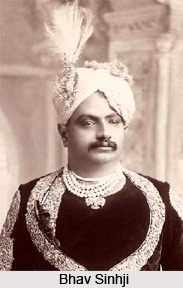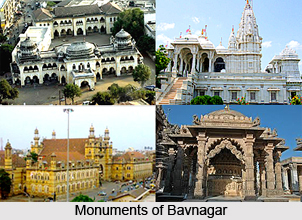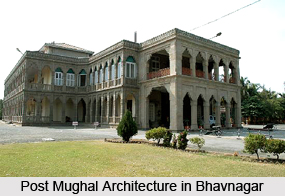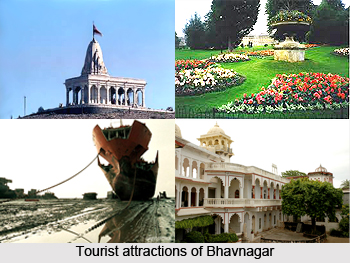 Bhavnagar is the fifth largest city in Gujarat. It is a place of great commercial importance because of its proximity with the Gulf of Cammbay and the Arabian Sea. Bhavnagar remained a major port, for almost two centuries, trading commodities with Africa, Mozambique, Zanzibar, Singapore and the Persian Gulf. The ship breaking yard of Alang(town in Bhavnagar district) is the biggest in the world, recycling about 50% of the salvaged ships of the world. Bhavnagar is an important center for diamond cutting and polishing industry in Gujarat as well as India.
Bhavnagar is the fifth largest city in Gujarat. It is a place of great commercial importance because of its proximity with the Gulf of Cammbay and the Arabian Sea. Bhavnagar remained a major port, for almost two centuries, trading commodities with Africa, Mozambique, Zanzibar, Singapore and the Persian Gulf. The ship breaking yard of Alang(town in Bhavnagar district) is the biggest in the world, recycling about 50% of the salvaged ships of the world. Bhavnagar is an important center for diamond cutting and polishing industry in Gujarat as well as India.
History of Bhavnagar , Gujarat
Bhavnagar was founded by Bhav Sinhji, a Rajput prince in 1743.He belonged to the Gohil Rajput clan that came to Saurashtra coast from Rajasthan in the 12th century because at that time the Gohil Rajputs of the Surya Vanshi clan were facing severe competition in Marwar and as a result moved to Gujarat and established three capitals- Sejakpur, Umrala and Sihor. Bhav Sinhji established a new capital near Vadva village, 20 km away from Sihor, and named it Bhavnagar. It was a carefully chosen strategic location having potential for maritime tradeBhav Sinhji was an able leader who established educational and judicial institutions. All the ruler`s that succeeded him contributed much to the development of the kingdom. The old town of Bhavnagar was a fortified town with gates leading to other important towns of the region. The rulers of Bhavnagar were so progressive that they commissioned European architects to build palaces and administrative buildings.
 Till independence of India in 1947, Bhavnagar State was ruled by the Gohil Rajput clan.
In 1948 Sardar Vallabhbhai Patel, Deputy Prime Minister of democratic Indian Union undertook the ambitious and complex process of political integration of India to unify 565 princely states with India. The last princely ruler of Bhavnagar was Late Sir Krishnakumar Sinhji who had handed over the administration of his State to the people`s representative in 1948, and Bhavnagar became the first state to unify with the democratic Indian Union. Bhavnagar was one among the princely states that joined the Indian Union after independence in 1947.
Till independence of India in 1947, Bhavnagar State was ruled by the Gohil Rajput clan.
In 1948 Sardar Vallabhbhai Patel, Deputy Prime Minister of democratic Indian Union undertook the ambitious and complex process of political integration of India to unify 565 princely states with India. The last princely ruler of Bhavnagar was Late Sir Krishnakumar Sinhji who had handed over the administration of his State to the people`s representative in 1948, and Bhavnagar became the first state to unify with the democratic Indian Union. Bhavnagar was one among the princely states that joined the Indian Union after independence in 1947.
Geography of Bhavnagar , Gujarat
Bhavnagar, the port city in Gujarat is located on the Saurashtra peninsula adjoining Gulf of Cambay. The city is also known as Kathiawar. It is located at 21.77° N 72.15° E and has an average elevation of 24 meters. The area of the city is 53.30 km square. Kansara Nala, a non perennial river, passes through outer area of the city.
Culture of Bhavnagar , Gujarat
Bhavnagar is known as the cultural capital of Saurashtra. The people here are easy-going, calm and art loving. The language spoken by the people of Bhavnagar is Guajrathi. The city has the credit of producing many poets and writers of Gujarati literature. Among them are Meghani, Kavi Kant, Prajaram Raval, Dula Kag, Subodh Mehta.
 Education of Bhavnagar , Gujarat
Education of Bhavnagar , Gujarat
Bhavnagar is a great center for education that experiments the new trends in rural and liberal child education. Liberal women`s education was born in Bhavnagar through the efforts of illustrious educator-social reformer Amrutlal Dani. The vibrant cluster of women`s schools and colleges today is due to his devoted and pioneer work.
The oldest institution of higher education in Bhavnagar is Bhavnagar`s Samaldas College. The father of the nation, Mahatma Gandhi studied here in 1884 AD. The Bhavnagar University is well known in the region for having 23,000 students, 17 post graduate departments including MBA, MCA, MSc, engineering, and medical colleges.
Some of the major educational institutions of Bhavnagar are Shree Dakshinamurti Vinay Mandir, BM Commerce High School, P.P.Institute of Science, Shamaldas Arts & Mehta Commerce College, Shantilal Shah High School (Alfred High School),
Sanatan Dharm high school etc.
Economy of Bhavnagar , Gujarat
The main economy of the people in Bhavanagar is agriculture. It is also an important center for diamond cutting and polishing industry in Gujarat as well as India. The main crops cultivated here are groundnut, onion, cotton, and bajra. Cotton, ship machinery and dehydrated onions are exported to other major countries.
 Bhavnagar is an important center for diamond cutting and polishing. Alang ship breaking yard at Bhavnagar is the biggest in the world that recycles about 50% of the salvaged ships of the world. This has also helped developing supporting industries, such as Oxygent bottling plants, re-rolling mills and induction furnaces.
The city is a prominent trading post for cotton products.
Bhavnagar is an important center for diamond cutting and polishing. Alang ship breaking yard at Bhavnagar is the biggest in the world that recycles about 50% of the salvaged ships of the world. This has also helped developing supporting industries, such as Oxygent bottling plants, re-rolling mills and induction furnaces.
The city is a prominent trading post for cotton products.
Demography of Bhavnagar , Gujarat
As per the 2001 census, Bhavnagar had a population of 510,958. Males constitute 52% of the population and females 48%. Bhavnagar has an average literacy rate of 72% of which 59.5% are males and 77% are females.
Transportation in Bhavnagar , Gujarat
Bhavnagar is well connected by air, rail and road. There are four flights a week to Mumbai. There are state transport buses connecting Bhavnagar with Ahmedabad and other centers in the region. Bhavnagar is 299km by rail from Ahmedabad. There`s one direct train daily, departing from Bhavnagar.
Places of interest in Bhavnagar , Gujarat
The important places of interest at Bhavnagar are:
•Jain temples of Talaja
•Ship breaking yard at Alang
• Janjmer fort
• Ruins of Shiyal
•Darbargadh
•Takteshwar Temple
•Barton Museum & Gandhi Smriti
•Victoria Park
•Ganga Devi Mandir
• Gandhi Smriti Museum
• Gaurishankar Lake



















